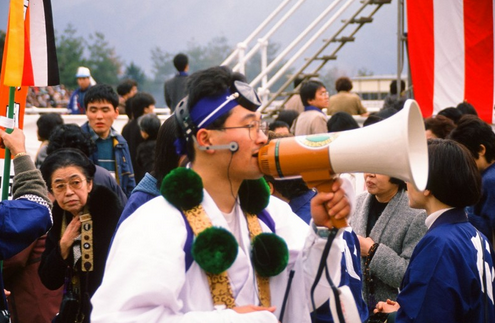Japan has a highly complex culture of religious traditions and of religious sites. Historically speaking, the main religious traditions have been those of Shinto and Buddhism – traditions that have mutually interacted, influenced and conflicted with each other across the centuries and produced numerous forms and sectarian branches. These are often portrayed as the ‘religious mainstream’ in Japan and are the most visible religious presence in the country with their numerous Buddhist temples and Shinto shrines throughout the country. They are particularly associated with customary practices, such as funeral rites and annual visits to shrines to pray for good fortune at the start of the year.
While these traditions have been the most widely portrayed aspects of the Japanese religious environment, academically and in the general literature about Japan, they are only a part of a broader religious landscape that incorporates various practices and organisational entities and that, while often drawing influences from the established traditions, stand apart from them. A common characteristic to them is that, in contrast to Shinto and Buddhism, which have traditionally been organised around and run by an ordained priesthood, they have been established by lay practitioners and operate as lay-centred movements.
The most striking phenomenon in such terms are the Japanese ‘new religions’ (Japanese: shinshūkyō 新宗教 ). These are movements that have emerged in Japan since the early nineteenth century – an era in which Japan was transformed from a feudal regime to a modern nation state. Gaining the support of millions of Japanese, yet also widely criticised by intellectuals and the media, and seen by many as controversial and out of step with modern times, such movements constitute the most striking religious development in modern Japan in institutional terms. Generally founded by inspirational figures who claim direct connections to the spiritual realms, and offering salvation, healing and other benefits, they have constructed their own hierarchies and offered a challenging religious alternative to the so-called mainstream. Some of the new religions, too, have expanded overseas and have followings around the world; some have gained a political foothold in Japan, while others have attained notoriety and attracted scandals
In this Special Project we provide profiles of a number of new religions that, because of their size, histories, dynamics and activities, have been especially prominent in the Japanese context. The introductory essay, ” Japanese New Religions: An Overview ” examines the new religions’ general characteristics and analysing the significance of these movements both collectively and individually. Our second focus is on other lay-centred religious groups that offer an alternative avenue of adherence and faith to the mainstream. Far less evident in studies of religion in Japan, such groups and movements are clearly ‘minority’ traditions, in that they rarely have large followings and may be confined to particular regions, but they constitute a striking element in the wider landscape, and in drawing attention to these as well, we hope to expand knowledge of the broader Japanese religious world.

PERSPECTIVES ON JAPANESE NEW RELIGIONS
“Japanese New Religions: An Overview“
PROFILES
- Agonshū
- Aum Shinrikyo
- Covert Shin Buddhists
- God Light Association
- Hikari No Wa
- Ijun
- Jiu
- Kōfuku no kagaku
- Reiki
- Risshō Kōseikai
- Seicho no Ie
- Shinnyo-en
- Sōka Gakkai
- Tenrikyō
- Tenshinseikyō
- Usui Reiki Ryōhō
- World Mate
For further information, contact:
Ian Reader, Erica Baffelli, , and Birgit Staemmler, Japanese New Religions Project Directors
Ian.Reader@manchester.ac.uk, erica.baffelli@manchester.ac.uk, birgit.staemmler@japanologie.uni-tuebingen.de
** The image on this page is used with permission and is taken from the Photo Archives of the Nanzan Institute for Religion and Culture, Nagoya, Japan.”
